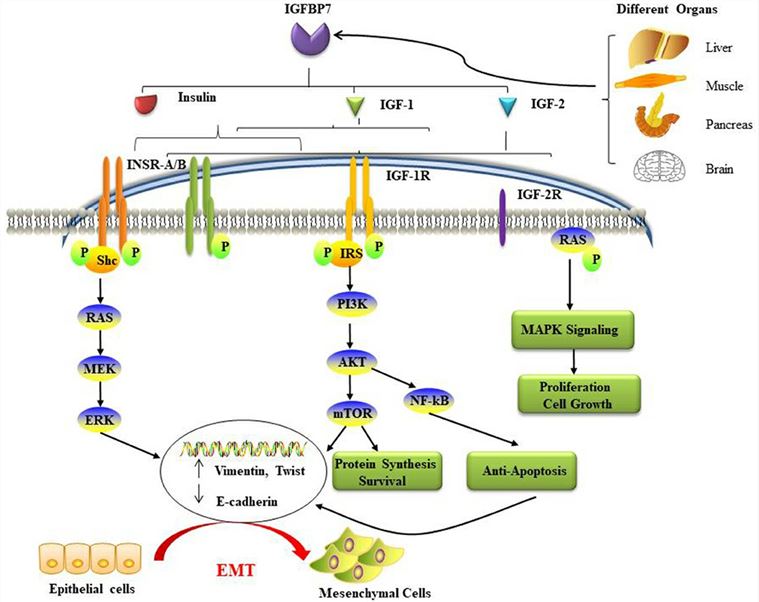What is IGFBP7 Protein?
The Insulin-like Growth Factor Binding Protein 7 or IGFBP7 is a bio-protein that has garnered interest in the world of molecular biology. This is majorly due to its potential role in cancer biology, and intriguing applications in biomedical sciences.
Background and Discovery of IGFBP7 Protein
The IGFBP7 gene was first discovered two decades ago, with researchers initially naming it TAF (Tumor-Derived Adhesion Factor) due to its enhanced expression in tumor cells. It received its current name once it was identified as a member of the insulin-like growth factor binding protein (IGFBP) superfamily. The gene for IGFBP7 is situated at the locus 4q12 on chromosome 4.
What Is The Structure of IGFBP7 Protein?
The IGFBP7 protein is 282 amino acids long, featuring a conserved N-terminal IGFBP motif and a thyroglobulin type-I like domain. The C-terminal domain of this protein is rich in cysteine and has a unique structure, with 18 cysteine residues forming multiple intramolecular disulfide bonds.
What Is The Function of IGFBP7 Protein?
In terms of its functional features, IGFBP7 plays a significant role in the regulation of insulin-like growth factors (IGFs). IGFs are important molecules involved in the cell cycle, such as cell division and apoptosis, and their effects can be either proliferative or anti-apoptotic. IGFBP7 sequesters the IGFs away from their receptors, thus reducing their bioavailability and survival signaling, which suggests its tumor-suppressive function.

Fig1. Insulin Growth Factor Binding Protein 7 (IGFBP7)
Furthermore, accumulated research indicates that the role of IGFBP7 extends beyond its IGF-binding function. IGFBP7 can also inhibit the RAS-MEK-ERK pathway, a well-established signal transduction pathway implicated in cell proliferation, differentiation, and migration. IGFBP7 binds to unprocessed forms of RAS proteins and subsequently prevents the activation of downstream kinases, thereby inhibiting the entire pathway. This further supports its potential anti-tumor activity.
IGFBP7 protein related diseases
Given its significant roles in cell cycle regulation and signal transduction, dysregulation of IGFBP7 is linked to various diseases, specifically cancers. Reduced expression of IGFBP7 has been observed in many types of tumors, such as breast, colorectal, and lung cancers, underscoring its potential as a tumor suppressor. Interestingly, in some cancers like malignant melanoma and mesothelioma, an increased expression of IGFBP7 is reported, potentially due to its role in promoting angiogenesis.
Moreover, recent studies have shown a potential association between IGFBP7 and metabolic syndrome. Patients with metabolic syndrome show a reduced IGFBP7 level, suggesting the role of IGFBP7 in maintaining metabolic homeostasis.
IGFBP7 protein's applications in biomedical
The unique functional profile of IGFBP7 serves as a foundation for potential biomedical applications. In cancer biology, its expression level can be used as a therapeutic marker. Recombinant IGFBP7 protein could also allow for new treatment possibilities, aiming to restore its expression in tumors where it is lowered. In addition, its role in angiogenesis makes IGFBP7 a potential therapeutic target in diseases characterized by abnormal blood vessel formation, such as age-related macular degeneration.
Moreover, the involvement of IGFBP7 in metabolic syndrome opens new avenues for addressing a major global health issue. Understanding and manipulating the role of this protein through targeted drugs could provide an innovative approach for the management of metabolic disorders.
In summary, the IGFBP7 protein, while a member of the well-studied IGFBP family, has unique properties that distinguish it from its siblings. It is likely to continue to attract scientific interest due to its diverse roles in cell growth, signal transduction, and involvement in various disease states. Its potential for translating into clinical applications in oncology and metabolic diseases presents the promise for developing innovative, targeted therapies.
Our Featured Products
| Cat.No. | Product Name | Species | Source (Host) | Tag |
|---|---|---|---|---|
| IGFBP7-6957H | Active Recombinant Human IGFBP7 protein, His-tagged | Human | HEK293 | His |
| IGFBP7-529H | Recombinant Human IGFBP7 Protein, MYC/DDK-tagged | Human | HEK293 | Myc/DDK |
| IGFBP7-1630H | Recombinant Human IGFBP7, His-tagged | Human | Mammalian cells | His |
| IGFBP7-55H | Recombinant Human IGFBP7 | Human | E.coli | N/A |
| IGFBP7-3141H | Recombinant Human IGFBP7 Protein, His (Fc)-Avi-tagged | Human | HEK293 | His (Fc)-Avi |
| IGFBP7-1604H | Active Recombinant Human IGFBP7 protein, His-Avi-tagged, Biotinylated | Human | HEK293 | His-Avi |
| IGFBP7-160H | Recombinant Human IGFBP7 Protein (Ser27-Leu282), N-His-SUMO tagged, Animal-free, Carrier-free | Human | HEK293 | N-His-SUMO |
Reference
- Jin Li, Shen Fan, Weinfeld Michael, Sergi Consolato. (2020). Insulin Growth Factor Binding Protein 7 (IGFBP7)-Related Cancer and IGFBP3 and IGFBP7 Crosstalk. Frontiers in Oncology. DOI=10.3389/fonc.2020.00727

